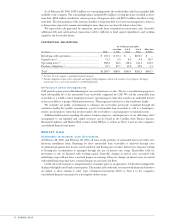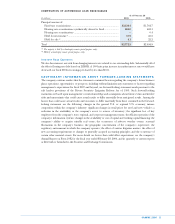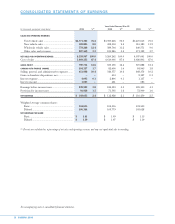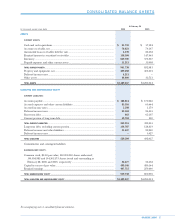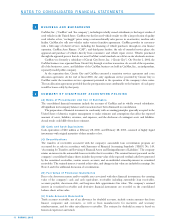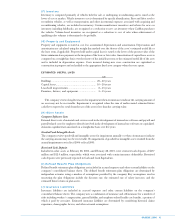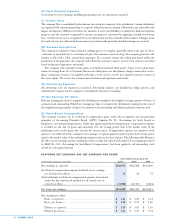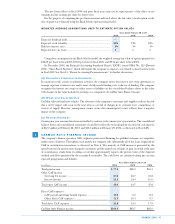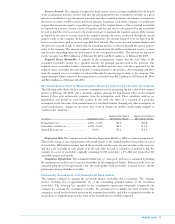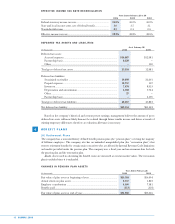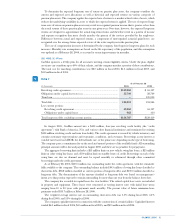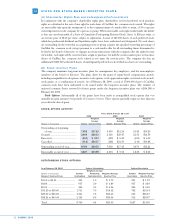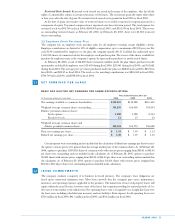CarMax 2006 Annual Report Download - page 46
Download and view the complete annual report
Please find page 46 of the 2006 CarMax annual report below. You can navigate through the pages in the report by either clicking on the pages listed below, or by using the keyword search tool below to find specific information within the annual report.
44
CARMAX 2006
CarMax Auto Finance income does not include any allocation of indirect costs or income. The company
presents this information on a direct basis to avoid making arbitrary decisions regarding the indirect benefit or
costs that could be attributed to CAF. Examples of indirect costs not included are retail store expenses, retail
financing commissions, and corporate expenses such as human resources, administrative services, marketing,
information systems, accounting, legal, treasury, and executive payroll.
SECURITIZATIONS
The company uses a securitization program to fund substantially all of the automobile loan receivables
originated by CAF. The company sells the automobile loan receivables to a wholly owned, bankruptcy-remote,
special purpose entity that transfers an undivided interest in the receivables to a group of third-party investors.
The special purpose entity and investors have no recourse to the company’s assets. The company’s risk is
limited to the retained interest on the company’s consolidated balance sheets. The investors issue commercial
paper supported by the transferred receivables, and the proceeds from the sale of the commercial paper are
used to pay for the securitized receivables. This program is referred to as the warehouse facility.
The company routinely uses public securitizations to refinance the receivables previously securitized through
the warehouse facility. In a public securitization, a pool of automobile loan receivables is sold to a bankruptcy-
remote, special purpose entity that in turn transfers the receivables to a special purpose securitization trust. The
securitization trust issues asset-backed securities, secured or otherwise supported by the transferred receivables,
and the proceeds from the sale of the securities are used to pay for the securitized receivables. Depending on
securitization structures and market conditions, refinancing receivables in a public securitization may or may not
have a significant impact on the company’s results. The company recognized a gain of $0.02 per share in fiscal
2006 related to three such refinancings. In future years, the impact of refinancing activity will depend upon the
particular securitization structures and market conditions at the refinancing date.
All transfers of receivables are accounted for as sales in accordance with SFAS No. 140. When the receivables
are securitized, the company recognizes a gain or loss on the sale of the receivables as described in Note 3.
Years Ended February 28 or 29
(In millions) 2006 2005 2004
Net loans originated ................................................................... $1,774.6 $1,490.3 $1,407.6
Total loans sold........................................................................... $1,887.5 $1,534.8 $1,390.2
Total gain income(1) ..................................................................... $ 77.1 $ 58.3 $ 65.1
Total gain income as a percentage of total loans sold(1) ............ 4.1% 3.8% 4.7%
(1) Includes the effects of valuation adjustments, new public securitizations, and the repurchase and resale of receivables in existing
public securitizations.
Retained Interest
The company retains an interest in the automobile loan receivables that it securitizes. The retained interest,
presented as a current asset on the company’s consolidated balance sheets, serves as a credit enhancement for
the benefit of the investors in the securitized receivables. The retained interest includes the present value of
the expected residual cash flows generated by the securitized receivables, or “interest-only strip receivables,”
various reserve accounts, and an undivided ownership interest in the securitized receivables, or “required
excess receivables,” as described below. On a combined basis, the reserve accounts and required excess
receivables are generally 2% to 4% of managed receivables. The special purpose entities and the investors
have no recourse to the company’s assets.
The fair value of the retained interest was $158.3 million as of February 28, 2006, and $148.0 million as
of February 28, 2005. The retained interest had a weighted average life of 1.5 years as of February 28, 2006,
and February 28, 2005. As defined in SFAS No. 140, the weighted average life in periods (for example,
months or years) of prepayable assets is calculated by multiplying the principal collections expected in each
future period by the number of periods until that future period, summing those products, and dividing the
sum by the initial principal balance.
Interest-Only Strip Receivables. Interest-only strip receivables represent the present value of residual cash
flows the company expects to receive over the life of the securitized receivables. The value of these receivables is
determined by estimating the future cash flows using management’s assumptions of key factors, such as finance
charge income, default rates, prepayment rates, and discount rates appropriate for the type of asset and risk. The
value of interest-only strip receivables may be affected by external factors, such as changes in the behavior
patterns of customers, changes in the strength of the economy, and developments in the interest rate markets;
therefore, actual performance may differ from these assumptions. Management evaluates the performance of the
receivables relative to these assumptions on a regular basis. Any financial impact resulting from a change in
assumptions is recognized in earnings in the period in which it occurs.
4


